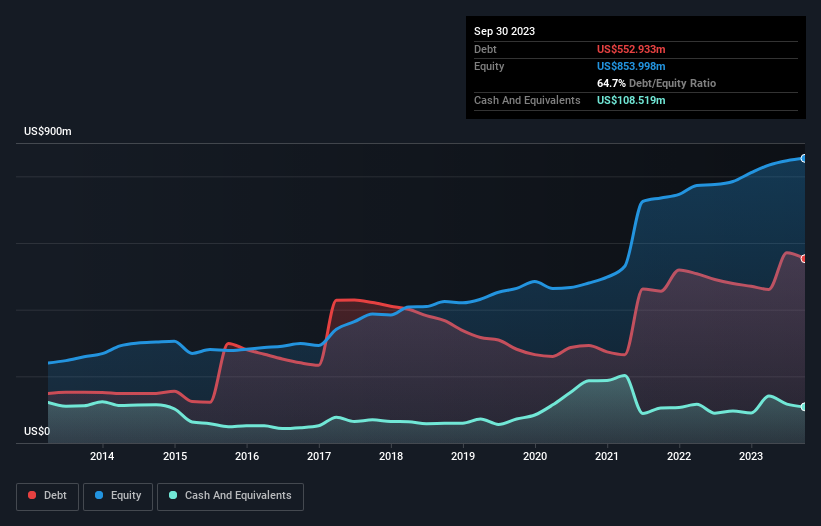- United States
- /
- Machinery
- /
- NasdaqGS:CMCO
Does Columbus McKinnon (NASDAQ:CMCO) Have A Healthy Balance Sheet?
Legendary fund manager Li Lu (who Charlie Munger backed) once said, 'The biggest investment risk is not the volatility of prices, but whether you will suffer a permanent loss of capital.' So it might be obvious that you need to consider debt, when you think about how risky any given stock is, because too much debt can sink a company. We can see that Columbus McKinnon Corporation (NASDAQ:CMCO) does use debt in its business. But should shareholders be worried about its use of debt?
Why Does Debt Bring Risk?
Generally speaking, debt only becomes a real problem when a company can't easily pay it off, either by raising capital or with its own cash flow. Part and parcel of capitalism is the process of 'creative destruction' where failed businesses are mercilessly liquidated by their bankers. While that is not too common, we often do see indebted companies permanently diluting shareholders because lenders force them to raise capital at a distressed price. Of course, plenty of companies use debt to fund growth, without any negative consequences. The first step when considering a company's debt levels is to consider its cash and debt together.
See our latest analysis for Columbus McKinnon
What Is Columbus McKinnon's Net Debt?
As you can see below, at the end of September 2023, Columbus McKinnon had US$552.9m of debt, up from US$478.4m a year ago. Click the image for more detail. However, it also had US$108.5m in cash, and so its net debt is US$444.4m.

How Healthy Is Columbus McKinnon's Balance Sheet?
The latest balance sheet data shows that Columbus McKinnon had liabilities of US$263.6m due within a year, and liabilities of US$709.8m falling due after that. Offsetting these obligations, it had cash of US$108.5m as well as receivables valued at US$169.2m due within 12 months. So it has liabilities totalling US$695.7m more than its cash and near-term receivables, combined.
This deficit is considerable relative to its market capitalization of US$1.09b, so it does suggest shareholders should keep an eye on Columbus McKinnon's use of debt. This suggests shareholders would be heavily diluted if the company needed to shore up its balance sheet in a hurry.
In order to size up a company's debt relative to its earnings, we calculate its net debt divided by its earnings before interest, tax, depreciation, and amortization (EBITDA) and its earnings before interest and tax (EBIT) divided by its interest expense (its interest cover). Thus we consider debt relative to earnings both with and without depreciation and amortization expenses.
Columbus McKinnon has a debt to EBITDA ratio of 3.1 and its EBIT covered its interest expense 3.1 times. This suggests that while the debt levels are significant, we'd stop short of calling them problematic. On a slightly more positive note, Columbus McKinnon grew its EBIT at 14% over the last year, further increasing its ability to manage debt. When analysing debt levels, the balance sheet is the obvious place to start. But ultimately the future profitability of the business will decide if Columbus McKinnon can strengthen its balance sheet over time. So if you're focused on the future you can check out this free report showing analyst profit forecasts.
Finally, while the tax-man may adore accounting profits, lenders only accept cold hard cash. So we clearly need to look at whether that EBIT is leading to corresponding free cash flow. Over the most recent three years, Columbus McKinnon recorded free cash flow worth 56% of its EBIT, which is around normal, given free cash flow excludes interest and tax. This cold hard cash means it can reduce its debt when it wants to.
Our View
Both Columbus McKinnon's interest cover and its net debt to EBITDA were discouraging. At least its EBIT growth rate gives us reason to be optimistic. We think that Columbus McKinnon's debt does make it a bit risky, after considering the aforementioned data points together. Not all risk is bad, as it can boost share price returns if it pays off, but this debt risk is worth keeping in mind. When analysing debt levels, the balance sheet is the obvious place to start. However, not all investment risk resides within the balance sheet - far from it. We've identified 1 warning sign with Columbus McKinnon , and understanding them should be part of your investment process.
Of course, if you're the type of investor who prefers buying stocks without the burden of debt, then don't hesitate to discover our exclusive list of net cash growth stocks, today.
New: AI Stock Screener & Alerts
Our new AI Stock Screener scans the market every day to uncover opportunities.
• Dividend Powerhouses (3%+ Yield)
• Undervalued Small Caps with Insider Buying
• High growth Tech and AI Companies
Or build your own from over 50 metrics.
Have feedback on this article? Concerned about the content? Get in touch with us directly. Alternatively, email editorial-team (at) simplywallst.com.
This article by Simply Wall St is general in nature. We provide commentary based on historical data and analyst forecasts only using an unbiased methodology and our articles are not intended to be financial advice. It does not constitute a recommendation to buy or sell any stock, and does not take account of your objectives, or your financial situation. We aim to bring you long-term focused analysis driven by fundamental data. Note that our analysis may not factor in the latest price-sensitive company announcements or qualitative material. Simply Wall St has no position in any stocks mentioned.
About NasdaqGS:CMCO
Columbus McKinnon
Designs, manufactures, and markets motion solutions for moving, lifting, positioning, and securing materials worldwide.
Average dividend payer with slight risk.
Similar Companies
Market Insights
Community Narratives




